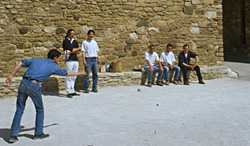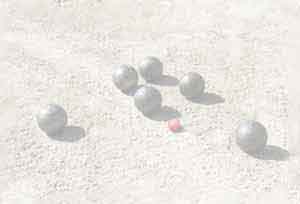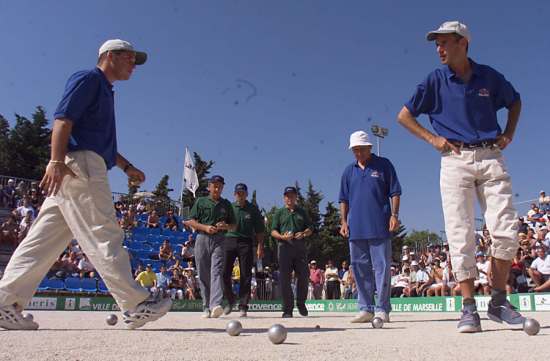Last update of this page 02/25/2001
What is the pétanque - History




The pétanque is a very typical french game, it's been a custom of the
south of the France since the XX century;
Although pétanque at tournament level is normally played on a flat, specially-prepared
surface, the tradition of the game allows a wide variety of surfaces to be pressed into
service. Walkways in public parks are often very suitable, as are many school playgrounds
and other hard-packed dirt areas. In the USA, a baseball diamond can be a very apt choice.
The game can be played (albeit less effectively) on grass lawns or even on ashphalt with a
light dusting of sand. Just about the only surface that is definitley not suitable is a
sandy beach, however -- special light plastic "beach pétanque" balls can be
obtained to make beach play possible.
The game must be played between two competing teams. However, the size of each team can
vary from one (mano a mano style) to four or even more at a pinch. Thus any group of
people numbering between two and perhaps ten can enjoy a game. By far the most usual team
make-ups are two against two (doublettes), and three against three (triplettes). In
doublettes each player plays three boules, and in triplettes two; so the total number of
boules in the game is almost always twelve.
So, you've selected your location, got some friends together with some regulation
cochonnet. What now? Well, you need one final item of equipment -- a coin to toss to see
which team goes first.
A player of the team winning the toss selects a starting place and scratches a circle in
the ground approximately 1-1/2 foot in diameter (officially 35 to 50 centimeters). He or
she then tosses the cochonnet a distance of from six to ten meters (6-1/2 to 11 yards) in
any direction; however, it is technically invalid if it ends up less than half a meter (1
1/2 feet) from any wall, tree or other obstacle. As a guide, a meter is a good full pace
taken by a fairly tall man.
The game proper starts when a player of the first team, standing with both feet together
within the circle, throws a boule and attempts to place it as near as possible to the
cochonnet, preferably between him and the cochonnet. The second team must then play until
at least one of its boules is closer to the cochonnet than the first team's boule. This
can be accomplished either by more accurate placing of a boule, or by violently shooting
the adversary boule out of the game by impact.
Assuming the second team achieves this before running out of boules, the first team then
plays until successful or out of boules, and so on alternately until all the boules of
both teams have been played.
If the cochonnet is displaced, the game continues unless the cochonnet either goes outside
an agreed perimeter, or cannot be seen from the circle. In that case the round is annulled
and re-started; however, if the cochonnet is knocked away when one team has thrown all its
boules and the other team still has boules in hand, the team with the boules earns one
point for each one that it has not played.
When both teams have thrown all their boules, the round is complete and the points are
determined. The winning team receives one point for each boule closer than any boule of
the opposing team (Thus the maximum possible score in any one round is normally six). A
player of the team winning the round again throws the cochonnet and another round begins.
The game usually ends when one team has accumulated 13 points.
This information of this part come from the site of Pétanque USA

Pétanque : sport de boules d'origine méridionale dont le nom vient de l'expression "pés tanqués" qui signifie pieds joints.
The "petanque" is a quite recent game but the games with bowls have existed
since the antique civilisations. The archeologists found this sort of game in all the
civilised population. For instance, somes bowls were found in a tomb in Egypt in 5200 BC,
so, the pharaons should know this game. We found again this game in Greece, under
"Alexandre le grand" where people practiced the throw of th bowls. Some sites
were reserved for this activity.
With the Romans, the dexterity replaced the force. The cochonnet appeared. The Romans
introduced this game in the Gaul during their conquest. In particular in Massilia
(Marseille) around 600 BC and after in Lugdumum (Lyon).
The game of bowls spreaded on all the Gaul, and during the Middle Ages, it became very
popular with the canon's bowls. Edouard III, the kind of Britain, like Charles V the wise,
wanted to forbid this game for the army because the soldiers deserted the training. In
France, the kind instuted a severe reglementation.
In spite of other bans in France, in particular by the parlement in 1629 under the pressure of the fabricants of the "jeu de paume" who were bothered by the competition, by the Synode of Paris in 1697 for the priests , by the of Marseille in 1870 for the national guard... this game quickly progressed and the diversity of the local rules gave birth to several games : the Lyonnaise, the rafle... The medecine underlined some benefits of this game, so the nobility confiscate this game at the people, until the night of august the 4th in 1789 (French révolution). That is in the south of the France that the Provencal Game conquered all the village. This game has become a "Sports competition" since the end of the XIX centuary. The "Pétanque" started from 1910.
However, that is in the region of Lyon that this sport became official : the
"Lyonnaise" became a sport in 1850 with the creation of the first official club
"Le Clos Jouve". In 1906, the Lyonnaise and region federation was found, then in
1933 the National bowls federation which would be called the French Federation in 1942. At
the XIX centuary, while that the Lyonnaise bowls were rolling, in the south of the France,
the people took an avid interest in "La Longue" or "The provencal
game". These games require the same quality but the rules are more simple and the
location is "free". "The provencal game" would given birth to the
reference : "La pétanque". In 1927, the official rules were made. The FFPJP
(Federation française de pétanque et de jeu provencal) was made in 1945.
The word "Pétanque" comes from the provencal language (that language is not
used actually), and that means in french "Pied-tanqué" and in english
"joined-foot". Because when you play this game your foot are joined.
MARCHAND Olivier - marcholi@yahoo.fr
Back to the presentation - Back
to the summary